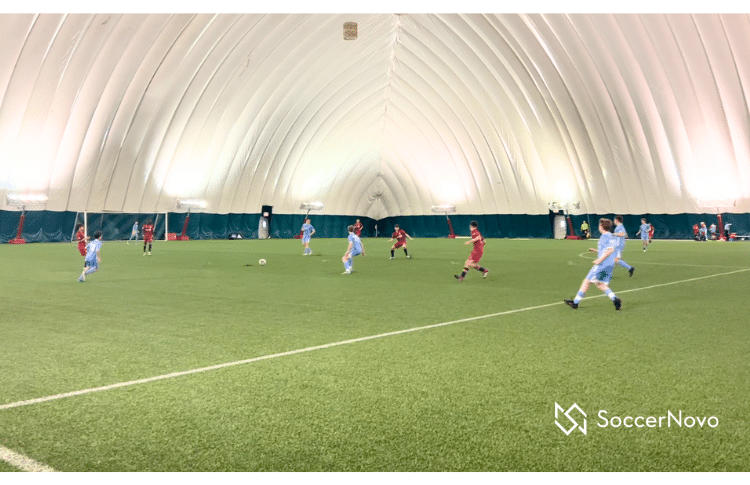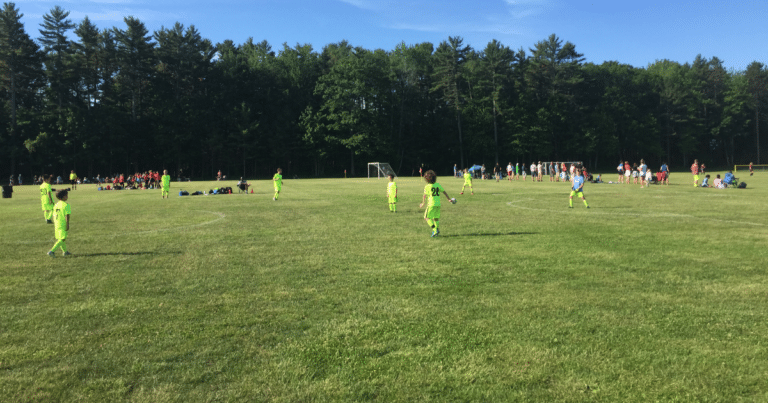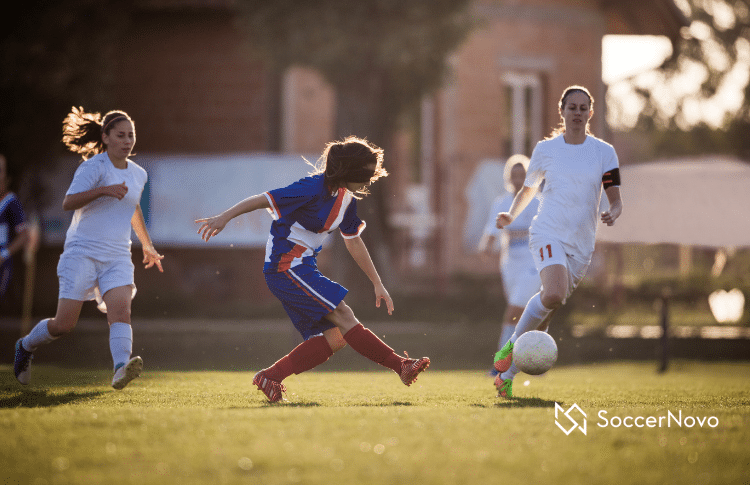How to Run Faster in Soccer
Learning how to run faster in soccer is a very helpful attribute for soccer players. Running faster can help you get to the ball quicker, make better passes, be a better defender, and score more goals.
How do you run faster? Fortunately, there are many ways to improve your speed on the field, from practicing drills to building strength and endurance.
By incorporating proper technique and workouts into your training regimen, you can become a faster, more effective soccer player in a matter of weeks.
Understanding the Basics of Speed
To become a faster soccer player, you need to understand the basics of speed. Speed is a combination of several factors, including aerobic and anaerobic fitness, muscle strength, and proper running technique.
In this section, we will explore the role of aerobic and anaerobic fitness and the importance of muscle strength in improving your speed.
The Role of Aerobic and Anaerobic Fitness
Aerobic fitness refers to your body’s ability to use oxygen to produce energy. This type of fitness is crucial for endurance sports like soccer, where you need to maintain a high level of activity for an extended period.
To improve your aerobic fitness, you should engage in activities like long-distance running, cycling, or swimming. These exercises can help increase your lung capacity, improve your cardiovascular health, and boost your endurance.
On the other hand, anaerobic fitness refers to your body’s ability to produce energy without oxygen. This type of fitness is essential for high-intensity activities like sprinting and jumping.
To improve your anaerobic fitness, you should engage in activities like interval training, plyometrics, and resistance training. These exercises can help increase your muscle strength, improve your speed, and enhance your explosive power.
The combo of these two things can accelerate your game on the field and make you a more dynamic player.
Importance of Muscle Strength
There’s no doubt that strong muscles can generate more power, allowing you to run faster and jump higher.
To improve your muscle strength, you should engage in exercises like squats, lunges, deadlifts, and calf raises. These exercises can help build your leg muscles and increase your power output.
It’s also essential to work on your core strength, as a strong core can help you maintain proper posture and balance while running.
Exercises like planks, sit-ups, and Russian twists can help strengthen your core muscles.
Proper Running Technique
To run faster in soccer, it is important to have proper running technique. This includes body posture and footwork. By improving your running technique, you can increase your speed and endurance on the field.
Body Posture
Your body posture is essential for proper running technique. Here are some tips to improve your body posture while running:
- Keep your head up and eyes forward. This will help you maintain balance and prevent injuries.
- Keep your shoulders relaxed and down. Tensing your shoulders can cause tension in your neck and upper back.
- Keep your arms close to your body and swing them back and forth. This will help you maintain balance and increase your speed. Try not to flail your arms around as this will cause more traction that will slow you down or lose your balance.
- Keep your core engaged and your back straight. This will help you maintain proper alignment and prevent injuries.
Footwork
Your footwork is also important for proper running technique. Here are some tips to improve your footwork while running:
- Land on the balls of your feet and roll onto your heels.
- Keep your feet close to the ground and avoid overstriding. This will help you maintain speed and prevent injuries.
- Push off with your toes and use your calf muscles to propel yourself forward. This will help you increase your speed and endurance.
- Keep your feet pointed straight ahead and avoid turning them inward or outward. This will help you maintain proper alignment.
By following these tips for proper running technique, you can improve your speed and endurance on the soccer field. Remember to practice these techniques regularly to make them a habit and improve your overall performance.
How to Run Faster With the Soccer Ball
Running with the soccer ball requires a combination of speed, control, and confidence.
It’s an essential skill that can help you create scoring opportunities, break through the defense, and win games.
With that said, it’s not always advantageous to run as fast as you can with the ball. Change of pace is also just as effective many times.
Here are some tips on how to run faster with the soccer ball:
1. Practice dribbling with both feet
To run faster with the soccer ball, you need to be comfortable dribbling with both feet. This will help you change direction quickly and evade defenders. Start by practicing basic dribbling drills with your weaker foot. Focus on keeping the ball close to your feet and using the inside and outside of your foot to control the ball.
If there is a good amount of space between you and the defender, you can push the ball out further on your dribble so you sprint to catch up to it. This will help you move faster with the ball.
2. Keep your head up
When you’re running with the soccer ball, it’s important to keep your head up and look for open spaces and passing opportunities. This will help you anticipate the movements of your teammates and the opposing team and make better decisions on the field.
3. Use your body to shield the ball
To protect the ball from defenders, use your body to shield the ball. This means positioning your body between the ball and the defender and using your arms to create space. Keep your knees bent and your center of gravity low to maintain your balance and stability.
4. Work on your acceleration and deceleration
To run faster with the soccer ball, you need to be able to accelerate and decelerate quickly. This means practicing explosive starts and stops, as well as changes of direction. Use cones or markers to set up drills that simulate game situations, such as dribbling through a series of defenders or making a sharp turn around a cone.
5. Improve your overall fitness
Finally, to run faster with the soccer ball, you need to be in good physical shape. This means working on your endurance, strength, and agility through regular exercise and training. Incorporate cardio workouts, strength training, and agility drills into your routine to improve your overall fitness and performance on the field.
Speed Training
There are several drills that you can do to improve your speed, agility, and endurance. Here are some of the most effective speed training drills that you can do.
Sprint Drills
Sprint drills are an excellent way to improve your maximum speed. You can do these drills on a track, soccer field, or any other flat surface. Here are some sprint drills that you can do:
- Straight Sprints: Run as fast as you can for 20-30 meters. Make sure to use proper form, including pumping your arms and driving your knees up.
- Hill Sprints: Find a hill with a steep incline and sprint up it as fast as you can. This drill will help improve your leg strength and explosiveness.
- Partner Resisted Sprints: Have a partner hold you back while you try to sprint forward. This drill will help improve your acceleration and power.
Agility Drills
Agility drills are essential for improving your ability to change direction quickly. These drills will help you improve your footwork, balance, and coordination. Here are some agility drills that you can do:
- Ladder Drills: Use a speed ladder to do various drills that will help improve your footwork and coordination.
- Cone Drills: Set up cones in a zig-zag pattern and practice running through them as quickly as possible.
- Box Drills: Set up cones in a square shape and practice running around them in different patterns.
Endurance Runs
Endurance runs are essential for improving your overall stamina and endurance. These runs will help you maintain your speed throughout the game and prevent you from getting tired too quickly. Here are some endurance runs that you can do:
- Long Distance Runs: Go for a long run at a steady pace. This run will help improve your cardiovascular endurance. Even 3 miles a few times a week can pay dividends.
- Interval Runs: Run at a high intensity for a short period and then slow down to a steady pace for a longer period. This run will help improve your anaerobic endurance.
- Fartlek Runs: This type of run involves alternating between fast and slow running. This run will help improve your overall endurance and speed.
Nutrition and Hydration
To run faster in soccer, you need to fuel your body with the right nutrition and hydration. A balanced diet and proper hydration can help you perform at your best on the field.
Balanced Diet
Eating a balanced diet is essential for soccer players. The simpler the diet, the better for young athletes. Your diet should include a variety of foods from different food groups, including:
- Carbohydrates: Carbohydrates are the primary source of energy for soccer players. Good sources of carbohydrates include whole grains, fruits, and vegetables.
- Protein: Protein is necessary for muscle growth and repair. Good sources of protein include lean meats, fish, beans, and nuts.
- Fats: Fats are important for energy and hormone production. Good sources of healthy fats include avocados, nuts, and olive oil.
- Vitamins and minerals: Vitamins and minerals are essential for overall health and performance. Good sources of vitamins and minerals include fruits, vegetables, and whole grains.
It’s important to eat a balanced diet throughout the day, including before and after games. Eating a meal that’s high in carbohydrates before a game can help you maintain your energy levels throughout the game. After a game, it’s important to eat a meal that’s high in protein to help your muscles recover.
Proper Hydration
Proper hydration is also crucial for soccer players, especially when playing in extreme temperatures. Dehydration can lead to decreased performance, fatigue, and even heat stroke. To stay properly hydrated, you should drink fluids before, during, and after games.
Water is the best choice for hydration, but sports drinks can also be beneficial during long games or in hot weather. Sports drinks, like Gatorade, can help replace electrolytes lost through sweat and provide carbohydrates for energy.
In addition to drinking fluids, you can also incorporate hydrating foods into your diet. Foods that are high in water content, such as fruits and vegetables, can help you stay hydrated throughout the day.
Importance of Recovery
To run faster, it is important to focus not only on training but also on recovery. Recovery is the process of allowing your body to rest and heal after intense physical activity.
It is crucial to prevent injuries and improve performance.
In this section, we will discuss the importance of recovery in soccer and two key aspects of recovery: rest and sleep and injury prevention.
Rest and Sleep
Rest and sleep are essential for recovery. When you rest, your body can repair damaged tissues, replenish energy stores, and remove waste products. Sleep is particularly important because it allows your body to produce growth hormone, which is essential for tissue repair and regeneration. Lack of sleep can lead to fatigue, decreased reaction time, and increased risk of injury.
To ensure that you are getting enough rest and sleep, it is important to create a recovery plan. This plan should include rest days, where you take a break from training, and sleep goals, where you aim to get a certain amount of sleep each night. It is recommended that adults get 7-9 hours of sleep per night, while teenagers need 8-10 hours.
The easiest way to accomplish this is to have a regular bedtime routine with established rules. For example, in our house, it’s no screen time after 8 pm and bedtime by 10:00 pm.
Injury Prevention
Injuries can sideline players for days, weeks or even months, preventing them from training and competing at their best.
To prevent injuries, it is important to warm up properly before training or games, stretch regularly, and cool down afterwards. It is also important to listen to your body and not push yourself too hard, too fast.
In addition to these basic injury prevention strategies, there are many other recovery techniques that can help prevent injuries and improve performance. These include:
- Massage therapy
- Foam rolling
- Ice baths
- Compression garments
- Nutritional supplements
It is important to remember that recovery is just as important as training when it comes to improving your speed and performance in soccer.
By incorporating rest and sleep into your recovery plan, and taking steps to prevent injuries, you can stay healthy and perform at your best.
Implementing Speed into Soccer Game
To become a successful soccer player, you need to be fast and agile. Speed is an essential component of soccer, and it can make all the difference in a game. In this section, we will discuss how to implement speed into your soccer game.
Positioning and Movement
Positioning and movement are crucial factors when it comes to implementing speed into your soccer game. You need to be in the right position to make the most of your speed. When you’re playing soccer, you need to be aware of your surroundings and anticipate where the ball is going to be. This means you need to be constantly moving and adjusting your position to be in the right place at the right time.
One way to improve your positioning and movement is to practice drills that focus on these skills. For example, you can practice moving quickly from side to side, or you can practice sprinting forward and then quickly changing direction. These types of drills will help you improve your agility and speed on the field.
Timing and Anticipation
Timing and anticipation are also critical when it comes to implementing speed into your soccer game. You need to be able to time your runs and anticipate where the ball is going to be. This means you need to be constantly scanning the field and looking for opportunities to make a run.
To improve your timing and anticipation, you can practice drills that focus on these skills. For example, you can practice running onto a ball that’s being passed to you, or you can practice making runs into space. These types of drills will help you improve your timing and anticipation on the field.
In conclusion, implementing speed into your soccer game requires a combination of positioning, movement, timing, and anticipation. By practicing drills that focus on these skills, you can improve your agility and speed on the field, and become a more successful soccer player.
Workouts to Consider
Sprint Training
Sprint training exercises are essential for improving your speed and explosiveness on the field. Some effective sprint training exercises for soccer players include:
- 10-yard sprints
- 20-yard sprints
- 40-yard sprints
- Shuttle runs
- Fartlek training
- Interval training
- Hill sprints
Shuttle Run
Improving your shuttle run time is crucial for soccer players, as it can help you quickly change direction and react to the game’s fast-paced nature. Here are some tips to improve your shuttle run time:
- Practice your footwork and agility drills
- Focus on maintaining proper form throughout the exercise
- Increase your speed gradually over time
- Incorporate interval training into your workout routine
Anaerobic exercises
Anaerobic exercises are high-intensity exercises that can help you build endurance and improve your speed. Some anaerobic exercises that can help you run faster in soccer include:
- Plyometric exercises
- High-intensity interval training (HIIT)
- Sled pushes and pulls
- Resistance band training
- Weight training
Hill Sprints
Hill sprints are an excellent way to build explosive power and speed. To incorporate hill sprints into your soccer training, follow these tips:
- Find a hill that is steep but not too steep
- Start with a few sets of 10-20 second sprints up the hill
- Gradually increase the number of sets and duration of sprints over time
- Focus on maintaining proper form and breathing throughout the exercise
Interval Running Workouts
Interval running workouts are an excellent way to improve your speed and endurance for soccer. Here are some interval running workouts to try:
- 30-second sprints followed by 30 seconds of rest
- 60-second sprints followed by 60 seconds of rest
- 4-minute runs followed by 1-minute rest
- 1-minute runs followed by 30 seconds of rest
Soccer Speed Training Drills with a Soccer Ball
Incorporating a ball into your speed training drills can help you improve your ball control and speed simultaneously. Some soccer speed training drills that involve using a ball include:
- Dribbling through cones at top speed
- Passing and receiving the ball while sprinting
- Shooting on goal while running at full speed
- Zigzag dribbling at high speed
Remember to always warm up and stretch before any exercise or training routine. Also, consult with a doctor or a fitness professional before starting any new exercise program.
Frequently Asked Questions
Does it help to be fast in soccer?
What does it mean to play fast in soccer?
Can I get faster without losing weight?

Written By: SoccerNovo
SoccerNovo is an independent youth soccer media brand built to help parents, players, and coaches better understand the game and the pathways available in U.S. soccer. Our mission is to make youth soccer simpler, clearer, and more accessible for everyone involved in it.
Let’s connect






